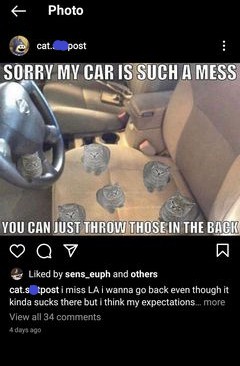Image Attribution: “VISA 1500 – SNS – Chloe Macus 2021” by Chloe Macus is licensed under CC0. (See interactive map)
The two social networking sites I use the most are Instagram, which I use for interpersonal communication, and YouTube, which I use for entertainment. I don’t create or alter any material, but I do consume for about 2 hours, and I share imagery about 3-5 times per day, and this has been recorded over the course of three days. The only time I use Instagram is to contact my friends and I use YouTube to find videos that will help me clean up my kickboxing techniques. Sometimes my friends and I share strange photos that we find funny. The photo attached is a perfect example of the weird sense of humour that we have adopted because of the internet.
For Instagram, I would say that there are a few pros to using the platform. The first is that the app instills a sense of community within people. For those that feel isolated from others in their life or don’t feel accepted by their peers, there is always some kind of community or group that will accept that person despite their differences. This feeling of not belonging is especially prevalent in the younger generation. It is said that “adolescents and young adults are the biggest users and the group most affected positively or negatively by social networks and media” (Yaqub, D’Amato, 2014). This sense of community is connected to the fact that social networks like Instagram allow people from all over the world to communicate with each other. I personally enjoy the fact that these social networking sites enable me to keep in touch with the side of my family that lives in Europe since I only see them every five years.
There is one major negative that I find dominant in image-sharing platforms like Instagram: it becomes a basis of self-worth and image. Celebrities post their lavish and “perfect” lives for everyone to see, and the result is individuals feeling that their lives aren’t adequate or exciting which can cause depression in some cases. The majority of what is put on social media is fabricated to make everyone’s lives look perfect and exciting when it probably isn’t that way in real life.
The positive aspect of YouTube is the vital information that is available on demand. There are endless amounts of videos on vastly different subjects like how to change a tire, give CPR, or defend yourself. “Social media promote self-education— users can find out what they want quickly and this can expedite the teaching and learning process” (Simonson, 2017). Anyone can learn anything at the simple and quick touch of a button.
A big con of YouTube is that there is such an abundance of videos currently being shared today that makes it is easy to get sucked into the platform and addicted. As I mentioned before, there are endless amounts of content on any kind of topic. You can start watching one video on a certain subject and a few hours later, end up at a completely different subject than you started with.
Yes, my behaviours and expectations in the past year have changed. It is unsettling to me how reliant we are all becoming on technology and social media to the point that I have started taking a step back from how much I use. I do feel that people these days are realizing our increasing reliance and are starting to distance themselves more from technology. But, even with that said, a large amount of what we do involves technology and I hope that will change in the future.
Works Cited
Simonson, M. (2017). Social media and online learning: Pros and cons. ProQuest. https://www.proquest.com/openview/221a2000a144f153b37dd23d91c7834a/1?pq-origsite=gscholar&cbl=29704
Yaqub, F. (2014). Asthma online: Pros and cons of social media and networks. The Lancet Respiratory Medicine, 2(6). https://doi.org/10.1016/S2213-2600(14)70079-7
